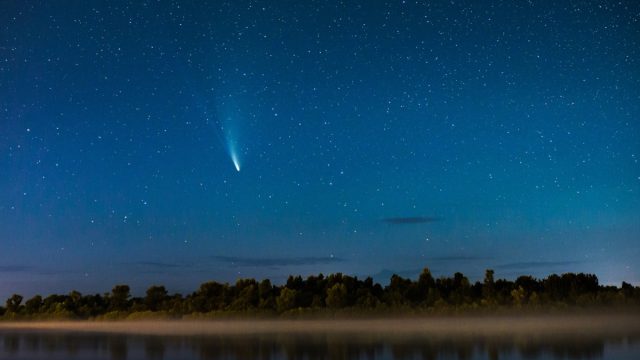Explosive “Devil Comet” Is at Its Brightest Before Disappearing Sunday—How to See It

The 2024 solar eclipse was hard to beat in terms of this year’s celestial events. Many of us ventured outside donning protective glasses to catch a glimpse, while others were lucky enough to experience the eerie darkness of totality (when the moon completely blocks the face of the sun). But 2024 is a big year for celestial occurrences, as the explosive “devil comet” is anticipated to be at its best and brightest in the next few days. Read on to find out how you can see it—it may be your last chance for over 70 years.
RELATED: 5 Places Where You Can See More Solar Eclipses in the Coming Years.
The comet has a formal name and two nicknames.

If you’re wondering how the “devil comet” got its name, it’s not due to anything seriously sinister.
According to NASA, the comet’s formal name is Comet 12P/Pons-Brooks, and it’s “one of the brightest known periodic comets.” It received its devilish nickname last year after an outburst gave the comet an “asymmetrical appearance” like it had horns.
But that’s not its only nickname. The European Space Agency (ESA) also dubbed the 12P/Pons-Brooks the “Mother of Dragons” comet, thanks to the fact that it is “the probable parent body of the ‘kappa-Draconids.'” (The kappa-Draconids is a small meteor shower active annually between Nov. 29 and Dec. 13.)
RELATED: 8 Amazing Things You Can See in the Night Sky Without a Telescope.
Head out at sunset to view the “devil comet.”

Comet 12P/Pons-Brooks flies near Earth every 71 years, and as it comes closer to the sun, it gets brighter and brighter in the night sky.
While early April was suggested as the ideal time to see the “devil comet,” you may not have missed out just yet, according to Live Science. Per NASA’s data, the comet will be at its closest point to the sun—144 million miles away–on Sunday, April 21. This point is formally known as perihelion.
In this position, the comet will be much brighter and easier to see in the western sky. The best views are likely just after the sun dips below the horizon. An hour after sunset, the comet will be too low to see, according to NASA. Two hours after sunset, the comet sets.
The stars need to align for you to see the comet with the naked eye.

At the start of April, the “devil comet” was visible with small telescopes and binoculars. And while its position in the night sky should make it easier to see this weekend, doing so with the naked eye could be a stretch. Live Science notes that Comet 12P/PonsBrooks has a magnitude of 5.9, with lower magnitudes indicating brighter objects. For reference, the brightest star in Earth’s night sky (Sirius) has a magnitude of -1.46, the outlet states.
“In spite of the fact that the comet should be brightest because it is nearest to the sun, it is quite distant from us,” Frank Maloney, an associate professor of astronomy and astrophysics at Villanova University in Pennsylvania, told Live Science. “Comets can exhibit major changes in brightness as the sun warms them, but unless something happens, the comet will be visible only in binoculars or a telescope.”
If the comet has another outburst—like the one last summer that gave it its horns—the situation with visibility could change.
Another outburst might not be too far-fetched, either. According to Live Science, the horns that the “devil comet” once sported haven’t been spotted in recent observations. This means that the comet probably lost the “notch” of ice in its core that made the horns possible.
RELATED: What Really Happens to Your Eyes If You Look Directly at a Solar Eclipse.
You may not have another chance to see Come 12P/Pons-Brooks.

Comet 12P/Pons-Brooks may shine its brightest on Sunday—and you’ll want to get out and catch a glimpse while you can.
According to Live Science, comets usually appear brightest when they get closest to Earth. While the “devil comet” will do so in June, those in the Northern Hemisphere won’t be able to see it due to its trajectory. At that time, it will only be visible from the Southern Hemisphere.
Once it’s officially too dim to view come July, we shouldn’t expect it back until 2095, according to the ESA.